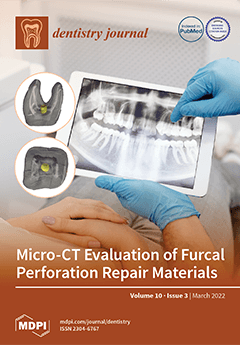Biomaterial–dentin interfaces undergo degradation over time, allowing salivary, tissue fluid, and bacterial movement between the root filling or restoration and dentin. This study aims to investigate the effect of aging in simulated human salivary/bacterial/blood esterases (SHSE) on proliferation and viability of
Enterococcus faecalis biofilm within the dentin interface with four materials used to fill/restore the endodontic space. Root canals of human anterior teeth were prepared and filled with gutta-percha and one of the following: self-cured resin composite (Bisfil
TM 2B, Bisco, Schaumburg, IL, USA) with either self-etch (SE) (EasyBond) or total-etch (TE) (Scotchbond
TM, 3M, Saint Paul, MN, USA) methacrylate-based adhesives, epoxy-resin sealer (AH Plus
®, Dentsply Sirona, York, PA, USA), or bioceramic sealer (EndoSequence
® BC Sealer™, Brasseler USA, Savannah, GA, USA). Specimens were aged in SHSE or phosphate-buffered saline (PBS) for up to 360 days, followed by cultivation of steady-state
E. faecalis biofilm. Depth and viability of interfacial bacterial biofilm proliferation were assessed by confocal laser scanning microscopy and live/dead staining. Data were analyzed using three-way ANOVA and Scheffe’s post hoc analyses. Initial depths of biofilm proliferation were similar among material groups (
p > 0.05). All groups showed significantly deeper biofilm proliferation with increased aging period (
p < 0.05). SHSE aging increased interfacial biofilm depth for TE, SE and BC (
p < 0.05) but not AH. For unaged interfaces, BC exhibited the lowest ratio of live bacteria, followed by AH, TE, and SE (
p < 0.05). Interfacial bacterial biofilm proliferation and viability were dependent on the biomaterial, aging media, and period.
Full article






